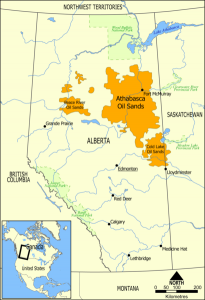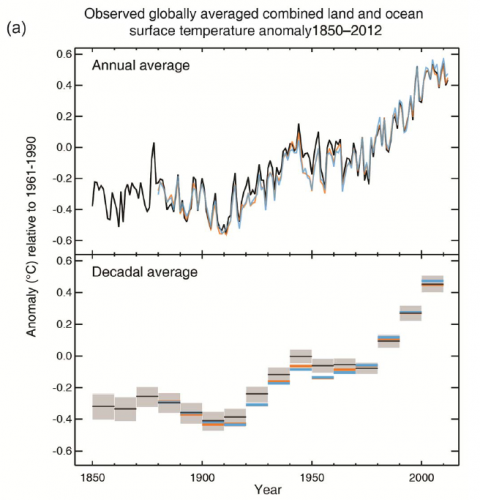Anyone reading pundits and politicians pontificating profusely about climate or environmental science will, at some point, have come across the “volcano gambit”. During the discussion they will make a claim that volcanoes (or even a single volcano) produce many times more pollutant emissions than human activities. Often the factor is extremely precise to help give an illusion of science-iness and, remarkably, almost any pollutant can be referenced. This “volcano gambit” is an infallible sign that indicates the author is clueless about climate science, but few are aware of its long and interesting history…
Carbon cycle
How do trees change the climate?
Guest commentary from Abby Swann (U. Washington)
This past month, an op-ed by Nadine Unger appeared in the New York Times with the headline “To save the climate, don’t plant trees”. The author’s main argument is that UN programs to address climate change by planting trees or preserving existing forests are “high risk” and a “bad bet”. [Ed. There is more background on the op-ed here]
However, I don’t think that these conclusions are supported by the science. The author connects unrelated issues about trees, conflates what we know about trees from different latitudes, and fails to convey the main point: tropical trees keep climate cool locally, help keep rainfall rates high, and have innumerable non-climate benefits including maintaining habitat and supporting biodiversity.
How much methane came out of that hole in Siberia?
Siberia has explosion holes in it that smell like methane, and there are newly found bubbles of methane in the Arctic Ocean. As a result, journalists are contacting me assuming that the Arctic Methane Apocalypse has begun. However, as a climate scientist I remain much more concerned about the fossil fuel industry than I am about Arctic methane. Short answer: It would take about 20,000,000 such eruptions within a few years to generate the standard Arctic Methane Apocalypse that people have been talking about. Here’s where that statement comes from:
[Read more…] about How much methane came out of that hole in Siberia?
Arctic and American Methane in Context
Lots of interesting methane papers this week. In Nature Geoscience, Shakhova et al (2013) have published a substantial new study of the methane cycle on the Siberian continental margin of the Arctic Ocean. This paper will get a lot of attention, because it follows by a few months a paper from last summer, Whiteman et al (2013), which claimed a strong (and expensive) potential impact from Arctic methane on near-term climate evolution. That economic modeling study was based on an Arctic methane release scenario proposed in an earlier paper by Shakhova (2010). In PNAS, Miller et al (2013) find that the United States may be emitting 50-70% more methane than we thought. So where does this leave us?
[Read more…] about Arctic and American Methane in Context
References
- N. Shakhova, I. Semiletov, I. Leifer, V. Sergienko, A. Salyuk, D. Kosmach, D. Chernykh, C. Stubbs, D. Nicolsky, V. Tumskoy, and �. Gustafsson, "Ebullition and storm-induced methane release from the East Siberian Arctic Shelf", Nature Geoscience, vol. 7, pp. 64-70, 2013. http://dx.doi.org/10.1038/NGEO2007
- G. Whiteman, C. Hope, and P. Wadhams, "Vast costs of Arctic change", Nature, vol. 499, pp. 401-403, 2013. http://dx.doi.org/10.1038/499401a
- N.E. Shakhova, V.A. Alekseev, and I.P. Semiletov, "Predicted methane emission on the East Siberian shelf", Doklady Earth Sciences, vol. 430, pp. 190-193, 2010. http://dx.doi.org/10.1134/S1028334X10020091
- S.M. Miller, S.C. Wofsy, A.M. Michalak, E.A. Kort, A.E. Andrews, S.C. Biraud, E.J. Dlugokencky, J. Eluszkiewicz, M.L. Fischer, G. Janssens-Maenhout, B.R. Miller, J.B. Miller, S.A. Montzka, T. Nehrkorn, and C. Sweeney, "Anthropogenic emissions of methane in the United States", Proceedings of the National Academy of Sciences, vol. 110, pp. 20018-20022, 2013. http://dx.doi.org/10.1073/pnas.1314392110
The new IPCC climate report
The time has come: the new IPCC report is here! After several years of work by over 800 scientists from around the world, and after days of extensive discussion at the IPCC plenary meeting in Stockholm, the Summary for Policymakers was formally adopted at 5 o’clock this morning. Congratulations to all the colleagues who were there and worked night shifts. The full text of the report will be available online beginning of next week. Realclimate summarizes the key findings and shows the most interesting graphs.
Update 29 Sept: Full (un-copyedited) report available here.
Global warming
It is now considered even more certain (> 95%) that human influence has been the dominant cause of the observed warming since the mid-20th century. Natural internal variability and natural external forcings (eg the sun) have contributed virtually nothing to the warming since 1950 – the share of these factors was narrowed down by IPCC to ± 0.1 degrees. The measured temperature evolution is shown in the following graph.
Figure 1 The measured global temperature curve from several data sets. Top: annual values. Bottom: averaged values over a decade.
[Read more…] about The new IPCC climate report
El Nino’s effect on CO2 causes confusion about CO2’s role for climate change
Are the rising atmospheric CO2-levels a result of oceans warming up? And does that mean that CO2 has little role in the global warming? Moreover, are the rising levels of CO2 at all related to human activity?
These are claims made in a fresh publication by Humlum et al. (2012). However, when seeing them in the context of their analysis, they seem to be on par with the misguided notion that the rain from clouds cannot come from the oceans because the clouds are intermittent and highly variable whereas the oceans are just there all the time. I think that the analysis presented in Humlum et al. (2012) is weak on four important accounts: the analysis, the physics, reviewing past literature, and logic.
[Read more…] about El Nino’s effect on CO2 causes confusion about CO2’s role for climate change
References
- O. Humlum, K. Stordahl, and J. Solheim, "The phase relation between atmospheric carbon dioxide and global temperature", Global and Planetary Change, vol. 100, pp. 51-69, 2013. http://dx.doi.org/10.1016/j.gloplacha.2012.08.008
Unlocking the secrets to ending an Ice Age
Guest Commentary by Chris Colose, SUNY Albany
It has long been known that characteristics of the Earth’s orbit (its eccentricity, the degree to which it is tilted, and its “wobble”) are slightly altered on timescales of tens to hundreds of thousands of years. Such variations, collectively known as Milankovitch cycles, conspire to pace the timing of glacial-to-interglacial variations.
Despite the immense explanatory power that this hypothesis has provided, some big questions still remain. For one, the relative roles of eccentricity, obliquity, and precession in controlling glacial onsets/terminations are still debated. While the local, seasonal climate forcing by the Milankovitch cycles is large (of the order 30 W/m2), the net forcing provided by Milankovitch is close to zero in the global mean, requiring other radiative terms (like albedo or greenhouse gas anomalies) to force global-mean temperature change.
The last deglaciation occurred as a long process between peak glacial conditions (from ~26-20,000 years ago) to the Holocene (~10,000 years ago). Explaining this evolution is not trivial. Variations in the orbit cause opposite changes in the intensity of solar radiation during the summer between the Northern and Southern hemisphere, yet ice age terminations seem synchronous between hemispheres. This could be explained by the role of the greenhouse gas CO2, which varies in abundance in the atmosphere in sync with the glacial cycles and thus acts as a “globaliser” of glacial cycles, as it is well-mixed throughout the atmosphere. However, if CO2 plays this role it is surprising that climatic proxies indicate that Antarctica seems to have warmed prior to the Northern Hemisphere, yet glacial cycles follow in phase with Northern insolation (“INcoming SOLar radiATION”) patterns, raising questions as to what communication mechanism links the hemispheres.
There have been multiple hypotheses to explain this apparent paradox. One is that the length of the austral summer co-varies with boreal summer intensity, such that local insolation forcings could result in synchronous deglaciations in each hemisphere (Huybers and Denton, 2008). A related idea is that austral spring insolation co-varies with summer duration, and could have forced sea ice retreat in the Southern Ocean and greenhouse gas feedbacks (e.g., Stott et al., 2007).
Based on transient climate model simulations of glacial-interglacial transitions (rather than “snapshots” of different modeled climate states), Ganopolski and Roche (2009) proposed that in addition to CO2, changes in ocean heat transport provide a critical link between northern and southern hemispheres, able to explain the apparent lag of CO2 behind Antarctic temperature. Recently, an elaborate data analysis published in Nature by Shakun et al., 2012 (pdf) has provided strong support for these model predictions. Shakun et al. attempt to interrogate the spatial and temporal patterns associated with the last deglaciation; in doing so, they analyze global-scale patterns (not just records from Antarctica). This is a formidable task, given the need to synchronize many marine, terrestrial, and ice core records.
[Read more…] about Unlocking the secrets to ending an Ice Age
References
- P. Huybers, and G. Denton, "Antarctic temperature at orbital timescales controlled by local summer duration", Nature Geoscience, vol. 1, pp. 787-792, 2008. http://dx.doi.org/10.1038/ngeo311
- L. Stott, A. Timmermann, and R. Thunell, "Southern Hemisphere and Deep-Sea Warming Led Deglacial Atmospheric CO 2 Rise and Tropical Warming", Science, vol. 318, pp. 435-438, 2007. http://dx.doi.org/10.1126/science.1143791
- A. Ganopolski, and D.M. Roche, "On the nature of lead–lag relationships during glacial–interglacial climate transitions", Quaternary Science Reviews, vol. 28, pp. 3361-3378, 2009. http://dx.doi.org/10.1016/j.quascirev.2009.09.019
- J.D. Shakun, P.U. Clark, F. He, S.A. Marcott, A.C. Mix, Z. Liu, B. Otto-Bliesner, A. Schmittner, and E. Bard, "Global warming preceded by increasing carbon dioxide concentrations during the last deglaciation", Nature, vol. 484, pp. 49-54, 2012. http://dx.doi.org/10.1038/nature10915
An Arctic methane worst-case scenario
Let’s suppose that the Arctic started to degas methane 100 times faster than it is today. I just made that number up trying to come up with a blow-the-doors-off surprise, something like the ozone hole. We ran the numbers to get an idea of how the climate impact of an Arctic Methane Nasty Surprise would stack up to that from Business-as-Usual rising CO2
Keystone XL: Game over?
The impending Obama administration decision on the Keystone XL Pipeline, which would tap into the Athabasca Oil Sands production of Canada, has given rise to a vigorous grassroots opposition movement, leading to the arrests so far of over a thousand activists. At the very least, the protests have increased awareness of the implications of developing the oil sands deposits. Statements about the pipeline abound.

[Read more…] about Keystone XL: Game over?
Good news for the earth’s climate system?
Guest Commentary by Jim Bouldin (UC Davis)
How much additional carbon dioxide will be released to, or removed from, the atmosphere, by the oceans and the biosphere in response to global warming over the next century? That is an important question, and David Frank and his Swiss coworkers at WSL have just published an interesting new approach to answering it. They empirically estimate the distribution of gamma, the temperature-induced carbon dioxide feedback to the climate system, given the current state of the knowledge of reconstructed temperature, and carbon dioxide concentration, over the last millennium. It is a macro-scale approach to constraining this parameter; it does not attempt to refine our knowledge about carbon dioxide flux pathways, rates or mechanisms. Regardless of general approach or specific results, I like studies like this. They bring together results from actually or potentially disparate data inputs and methods, which can be hard to keep track of, into a systematic framework. By organizing, they help to clarify, and for that there is much to be said.
[Read more…] about Good news for the earth’s climate system?
